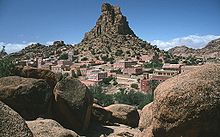Tiznit (Province)

The approximately 6000 km² large province of Tiznit ( Taschelhit ⵜⴰⵙⴳⴰ ⵏ ⵜⵉⵣⵏⵉⵜ ) is located in the southwest of the Souss-Massa region in southern Morocco and - after the secession of the Sidi Ifni province in 2009 - only has about 300,000 inhabitants. The capital of the province is the city of Tiznit .
geography
location
The province borders in the north with the province Chtouka-Aït Baha , in the northeast with the province Taroudannt , in the southeast with the province Tata , in the south with the province Sidi Ifni and in the west with the Atlantic Ocean .
landscape
There are only a few villages along the flat Atlantic coast - the two most important are Mirleft and Sidi Moussa d'Aglou ; the latter has beautiful sandy beaches. The slightly hilly area around the city of Tiznit is characterized by dry and stony soils on which no agriculture and hardly any cattle breeding is possible. To the east, the landscape profile increases significantly and the soils become somewhat more fertile. The R104 road leads over the 1100 m high Col du Kerdouz into the Anti-Atlas and to Tafraoute .
climate
While daytime temperatures of 40 ° C and more are reached in the city of Tiznit in summer, it is usually a little less on the Atlantic coast and in the mountains; even in winter the maximum daily temperatures are between 20 and 30 ° C. At night it cools down to 5 to 20 ° C, depending on the cloudiness.
economy
Agriculture
While no agriculture is possible on the predominantly dry and stony soils in the west of the province - apart from a little cattle breeding (sheep, goats), the situation in the mountain oases of the western Anti-Atlas is significantly different. Date palms even grow here, and cereals (especially barley ) and vegetables (especially potatoes and broad beans ) are grown on small plots . Livestock farming plays a subordinate role here. The same applies to the coastal strip near Mirleft.
Crafts, trade and tourism
The two cities of Tiznit and Tafraoute form the economic and tourist centers of the province. While Tiznit was a garrison town founded in the 19th century and later also used by the French during the colonial period , where handicrafts (especially gold and silversmiths), trade and transport flourished and are still of great importance today, Tafraoute was a long time only a small Berber village in the mountains, which, however, has developed into a tourist town due to its scenic surroundings and useful infrastructure. After the completion of the R105, which also leads from Agadir or Inezgane via Biougra and Aït Baha to Tafraoute, the importance of the small town has grown even more.
History and population
The province of Tiznit was only created in 1975 by splitting off from the former province of Agadir and reduced to its present size in 2009 by separating the province of Sidi Ifni . It consists of around 40 municipalities, including the two cities of Tiznit and Tafraoute. The province had a total of just under 345,000 inhabitants in 2004; 76% of them lived in rural communities and 24% in cities. No figures are yet available for 2012. The vast majority of the population are Berbers ; There is a strong urge to migrate from the mountain villages to the cities.
Attractions
The Souss Massa National Park with its rich flora and fauna stretches along the coast south of Agadir. It is mainly located in the province of Chtouka-Aït Baha, but also extends a little into the province of Tiznit. Further south is the coastal town of Mirleft . Tiznit impresses with its kilometer-long city wall and the lively hustle and bustle on the main square and the adjoining side streets. The area around Tafraoute with its granite rocks offers scenic attractions above all. The traditional clay buildings have largely disappeared and have been replaced by modern houses made of hollow blocks and concrete ceilings. A few of the old houses in the villages of Aday, Tazka and Oumesnat have been converted into interesting museums ( Maisons berbères ).

